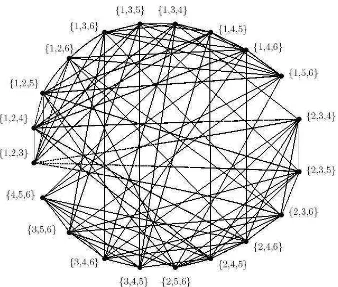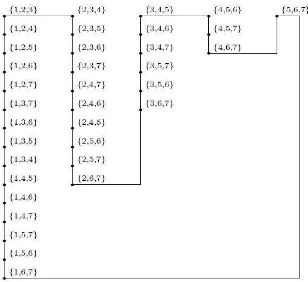Hamiltonicity of The Graph G(n, k) of The Johnson Scheme
Hans Riyono Ho Jurusan Sistem Informasi
Fakultas Teknologi Informasi ~ Universitas Kristen Maranatha Jl. Prof. Drg. Suria Sumantri No. 65 Bandung 40164
Email: [email protected], [email protected]
Abstrak
Grafik G(n,k) of the Johnson Scheme, biasa disebut juga “Slice of the Cube”, adalah grafik tanpa arah (undirected graph) dimana setiap vertex adalah k-subset dari n-set. Dua vertex A dan B adalah berdekatan dalam grafik G jika dan hanya jika | A ∩ B | = k – 1.
Grafik ini telah dipelajari secara intensif dan beberapa ciri telah ditemukan seperti hamiltonicity, diameter, connectivity dan wide-diameter dari grafik tersebut.
Dalam tulisan ini akan ditunjukkan alternatif pembuktian dari salah satu ciri, yaitu hamiltonicity dari grafik G(n,k).
Kata kunci: graph G(n,k) of the Johnson Scheme, subgraph, hamiltonian path, hamiltonian cycle, hamiltonicity.
1. Introduction
There are two classes of interconnection network topologies, static and dynamic. In a static network, the network nodes are interconnected by point-to-point links in
some fixed topology. Sometimes, these networks are also called direct networks
because the interconnecting links are directly connected to the network nodes. Static interconnection network topologies are derived from graphs in which nodes represent processors and edges represent the dedicated links among processors. In multi computer interconnection, static networks are used frequently because they have an important advantage. The degree of a node either remains fixed regardless of the size of the network or grows very slowly with network size. This allows very large networks to be constructed. Some examples of the static interconnection networks used in commercial and experimental systems are as follows. Hypercube is used in Connection Machine CM-2, 2-D Mesh is used in Stanford Dash, Intel Paragon, Intern Touchstone Delta and Illinois Illiac IV, 3-D Mesh is used in MIT J-Machine.
2. Definition of the graph G(n, k) of the Johnson Scheme
The graph G(n, k) of the Johnson Scheme is the undirected graph where the
vertices are all the k-subsets of a fixed n-set. Two vertices A and B are adjacent if
and only if | A ∩ B | = k-1.
From the definition of the graph G(n, k) of the Johnson Scheme, we know that the total number of vertices is
Consider the example. The total number of vertices is 20 and each vertex has 9 edges incident to it.
Consider the order of the elements in a vertex, we make a consensus that the order of the elements in a vertex is in non-decreasing order. This means that vertex with
elements {1,3,2} or {2,1,3} or {2,3,1} or {3,1,2} or {3,2,1} will be denoted by
{1,2,3}.
By this consensus, we divide the graph G(n, k) of the Johnson Scheme into
subgraphs Si such that each subgraph Si has vertices with a common first element,
a1.
Consider the example. The graph will have 4 subgraphs.
3. Hamiltonicity
In this paper we shall determine one of many properties of graph G(n, k) of the Johnson Scheme which is whether the graph is Hamiltonian or not. Even though this property has been proven by Zhang, F. et al., 1997, we shall prove it in another way.
Definition
A hamiltonian path of graph is a path which passes once through each vertex of a graph (except that it may be closed, that is, its first and last vertices may be the same).
A closed hamiltonian path or a hamiltonian cycle is a hamiltonian path where the first and last vertices are the same. A graph possessing such a circuit is called hamiltonian.
Hamiltonian Graph
We first prove the following lemmas.
Lemma 1: Each subgraph Si of the graph G(n, k) of the Johnson Scheme has a
that every vertex has exactly k elements.
Thus, each subgraph Si has a general form as follows.
Si = {{ai, a(i+1), a(i+2), . . . , a(i+k-2), a(i+k-1)},
We can examine the form and claim that two consecutive vertices are adjacent because the intersection of both is k - 1. Thus, there is hamiltonian path in every subgraph of the graph G(n, k) of the Johnson Scheme.
Lemma 2: The first vertex of subgraph Si is adjacent to the first vertex of subgraph
S(i+1). Proof:
Let A1 be the first vertex of subgraph S1 and B1 is the first vertex of subgraph S2. It
follows that A1 = {1, 2, 3, . . . , k}, B1 = {2, 3, 4, . . . , k + 1}, So, the intersection
between A1 and B1 is {2, 3, 4, . . . , k} which has cardinality k - 1. Thus, they differ
in only one element. For A1, it differs one element from B1 because it does not have
element k+1. And B1 differs one element from A1 because it does not have element
1. Thus, A1 is adjacent to B1. Let C1 be the first vertex of subgraph S3, that is C1 =
{3, 4, 5, . . . , k + 2}. The intersection between B1 and C1 is {3, 4, 5, . . . , k + 1}
between C1 and D1, D1 and E1, and so on, for D1 is the first vertex of subgraph S4,
and E1 is the first vertex of subgraph S5. In fact, the first vertex of subgraph Si is
always adjacent to the first vertex of subgraph S(i+1) of the graph G(n, k) of the
Johnson Scheme.
Lemma 3: The last vertex of subgraph Si is adjacent to the last vertex of subgraph
Sj , where i, j ≤ n - k + 1.
one element. For Ay, it differs one element from By because it does not have
element a2, and it differs one element from Cy because it does not have element a3.
For By, it differs one element from Ay because it does not have element a1, and it
differs one element from Cy because it does not have element a3. Thus, Ay is
adjacent to By and Cy. This adjacency also occurs between By and Cy, By and Dy, Cy
and Dy, and so on, for Dy is the last vertex of subgraph S4. Thus, the last vertex of
subgraph Si is always adjacent to the last vertex of subgraph Sj of the graph G(n, k)
of the Johnson Scheme, where i, j ≤ n - k + 1.
Lemma 4: The first vertex of subgraph S(n-k) is adjacent to the vertex of subgraph
S(n-k+1). Proof:
Note that in the last subgraph, S(n-k+1), has only one vertex. This vertex is the first
vertex and also the last vertex of subgraph S(n-k+1). So, this lemma is already proven
in Lemma 2.
Theorem: There is hamiltonian cycle in graph G(n, k) of the Johnson Scheme.
Proof:
We shall use the above lemmas to prove this theorem. Let Si is the ith subgraph, for
i = 1, 2, . . . , n - k + 1. If i is odd, we make an edge between the first vertex of subgraph Si and the first vertex of subgraph S(i+1) (Lemma 2), If i is even, we make
an edge between the last vertex of subgraph Si and the last vertex of subgraph S(i+1)
(Lemma 3). If i is equal to n - k + 1, we make an edge between the last vertex of
subgraph S1 and the vertex of subgraph S(n-k+1). Now, every subgraph has been
Based on the lemmas and theorem, we claim that:
Corollary: The graph G(n, k) of the Johnson Scheme is hamiltonian.
Consider this example, n = 7 and k = 3, then graph G(7, 3) has subgraphs as
follows:
S1 = {{1,2,3}, {1,2,4}, {1,2,5}, {1,2,6}, {1,2,7}, {1,3,7}, {1,3,6}, {1,3,5},
{1,3,4}, {1,4,5}, {1,4,6}, {1,4,7}, {1,5,7}, {1,5,6}, {1,6,7}}
S2 = {{2,3,4}, {2,3,5}, {2,3,6}, {2,3,7}, {2,4,7}, {2,4,6}, {2,4,5}, {2,5,6},
{2,5,7}, {2,6,7}}
S3 = {{3,4,5}, {3,4,6}, {3,4,7}, {3,5,7}, {3,5,6}, {3,6,7}}
S4 = {{4,5,6}, {4,5,7}, {4,6,7}}
S5 = {{5,6,7}}
If we draw those subgraphs with edges to see the hamiltonian cycle, then we shall get Figure 2.
4. Conclusion
In this paper, on the graph G(n, k) of the Johnson Scheme, we divide the whole graph into subgraphs which will make us easier to determine one of the graph property.
The whole discussions on the graph G(n, k) of the Johnson Scheme above give conclusion that the graph G(n, k) of the Johnson Scheme is hamiltonian.
References
[Bol93] Bollob_as, B., Quo Vadis, Graph Theory?, The Future of Graph Theory, 1993, Annals of Discrete Mathematics.
[Che87] Chen, L. and Lih K.W., Hamiltonian Uniform Subset Graph, in J. Combinatorial Theory, Series B, 1987.
[Dua97] Duato, J., Yalmanchili, S., Ni, L., Interconnection Networks an Engineering Approach, 1997, IEEE Computer Society Press.
[Har94] Harts_eld, N., Ringel, G., Pearls in Graph Theory, 1994, Academic Press. [Moo82] Moon, A., On the Uniqueness of the Graph G(n, k) of the Johnson Scheme, in J.
Combinatorial Theory, Series B, 1982.
[Mug00] Muga II, F.P., Caro, J.D.L., Adorna, H.N., and Baes, G., On the Wide-Diameter of the Graph G(n, k) of the Johnson Scheme of the First Order, 2000.
[Par94] Parthasarathy, K.R., Basic Graph Theory, 1994, Tata McGraw-Hill Publishing Company Limited.
[Zha97] Zhang, F., Lin, G. and Cheng, R., Some Distance Properties of the Graph G(n, k) of Johnson Scheme, in the International Congress of Algebra and

